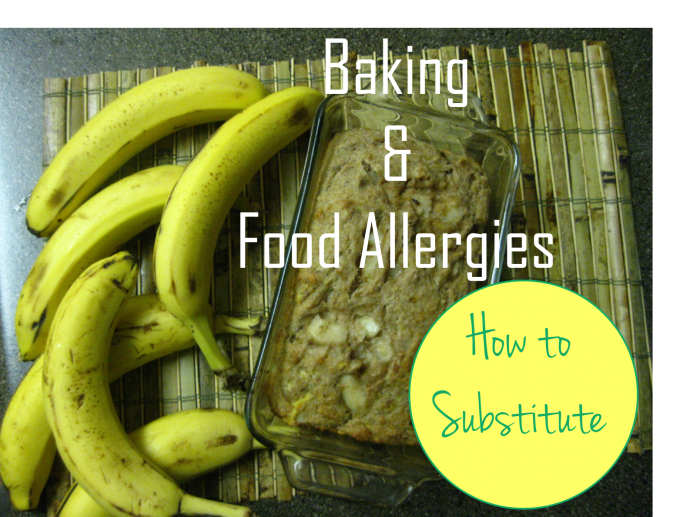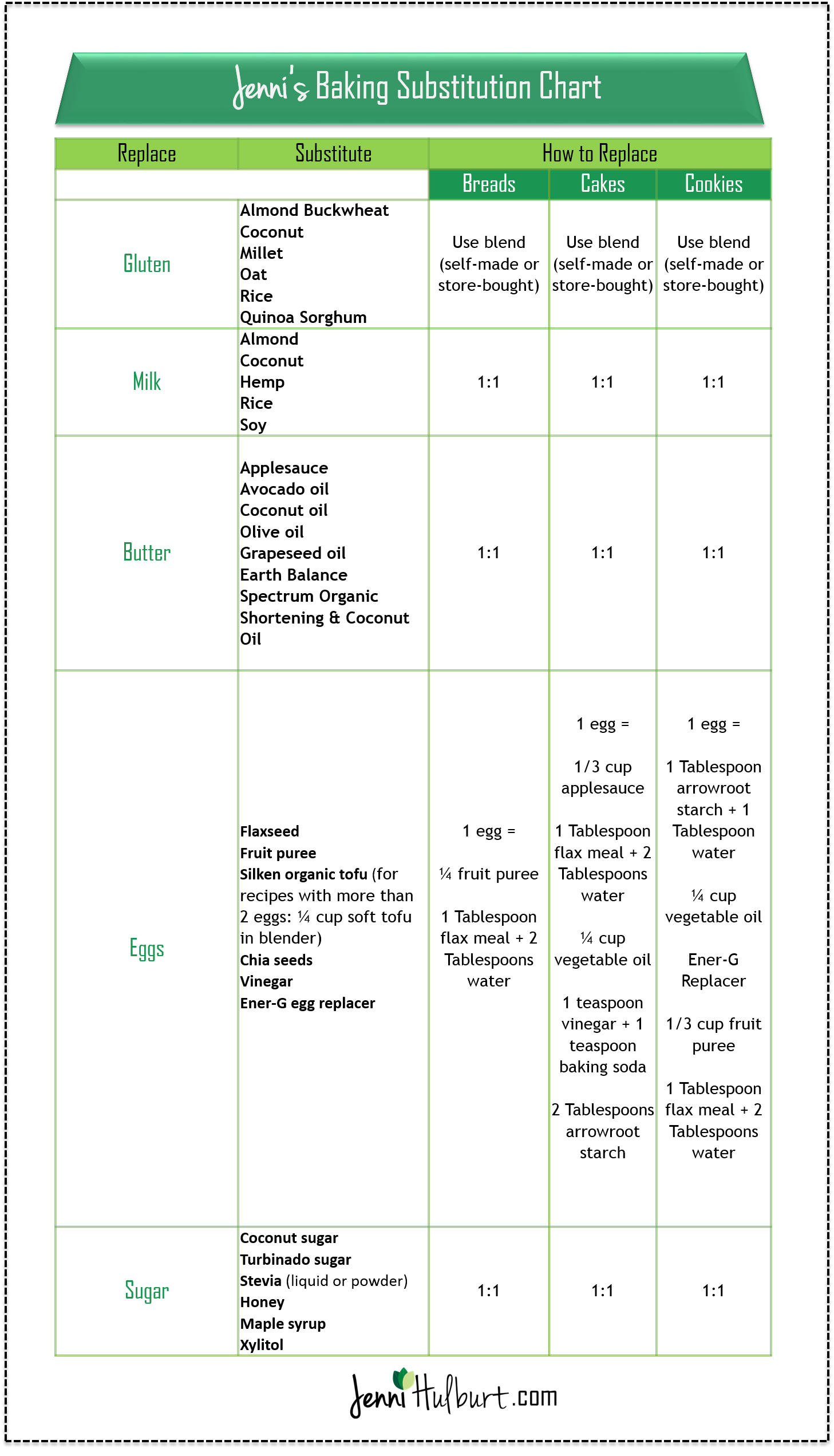
Baking and Food Allergies: How to Substitute Ingredients
It’s baking season!
Which one of these categories do you fall into?
- You have food allergies and want to enjoy all your favorite foods, without the usual ingredients.
- You have a family member or friend with food allergies, and you’re baking a gift or meal for them.
- You want to enjoy desserts without refined sugar, dairy, or gluten (and guilt, bloating, and fatigue).

Before I show you how to substitute ingredients like a pro, and enjoy just about any dish you wish… let’s get a few things out on the table.
- I have food allergies and intolerances to dairy, eggs, gluten, peanuts, and soy.
- I’m a big fan of desserts.
- Baking cookies is a memorable pastime in my family.
- I’m really good at modifying, adapting, and not following recipes.
Our relationship to food is so much deeper than physical nourishment, and that’s why my mission is preparing something that I can enjoy AND is good for my body.
So pull out your favorite organic apron. I’m going to show you how to make a cake… and eat it too!
(If you’re more of a visual learner who just needs a quick reference, you can skip the details and check out the chart I made for you at the end of this post).
Gluten
When it comes to gluten-free in baking, we’re usually talking about flour.
Gluten-Free Flours: almond, buckwheat, coconut, millet, oat, rice, quinoa, sorghum…
The challenge: Ratios. It’s not always as simple as making a 1:1 ratio substitute for wheat flour (if you’ve experienced brick-like bread or hockey-puck cookies, you learned the hard way).
Here’s a few tips:
- Almond, buckwheat, and oat can be used as stand-alone flours in a recipe, depending on the flavor you’re going for.
- Rice is OK in some recipes, but can be ‘grainy’ for cookies, and not binding enough in a cake.
- Quinoa, coconut, and sorghum are best used with a blend of other flours.
Try this: ¾ cup rice flour, ¾ cup sorghum flour, ½ cup tapioca starch.
Money-saver tip: Make your own flour using a high-powered blender like a Vita-mix. I usually blend whole, uncooked rice, quinoa, or almonds using this method.
Store-bought blends: Some of my favorite blends are the King Arthur Flour GF Multi-Flour Blend (rice-based), Pamela’s Artisan Flour Blend (most versatile), and Bob’s Red Mill All-Purpose Baking Flour (if you like bean flours – has a distinct flavor and not always the best for baked foods).
Dairy
In terms of baking, let’s talk milk and butter substitutes. Both are relatively easy because you can follow a 1:1 ratio – 1 cup of coconut oil for 1 cup of butter.
Milk Substitutes: almond, coconut, hemp, rice, soy
Butter Substitutes: applesauce, avocado oil, coconut oil, olive oil, grapeseed oil, Earth Balance products, Spectrum Organic Shortening and Coconut Oil
The challenge: Flavor. You may have to consider the flavor you’re going for in the end product. Coconut and extra-virgin olive oil have stronger flavors than other alternatives, but can be very good in certain recipes.
Try this: If the recipe calls for 1 cup butter, try ½ coconut oil + ½ unsweetened applesauce. You may even increase the applesauce if you like the flavor – it will add more moisture to the recipe.
Money-saver tip: Canned coconut milk is usually cheaper than what comes in a carton because it’s more concentrated. The thicker canned milk could be diluted before using in recipes. Store the rest in a glass Mason jar and use it in your smoothies.
Eggs
An important ingredient that can be left out or replaced easier than you might think. Yes they moisten, help with leavening, bind, and provide richness and flavor, but so does…
Egg Substitutes: Flaxseed, fruit puree, silken organic tofu, chia seeds, vinegar, Ener-G egg replacer
The challenge: Because eggs can add moisture, leavening, binding, or flavor, it’s important to ask the question: What am I looking to accomplish in this recipe?
Moisten
- 1/4 cup fruit puree: prunes, applesauce, banana, pear.
- 1/4 cup silken organic tofu, whipped
Leavening
- 1 teaspoon baking powder + 1 Tablespoon water + 1 Tablespoon vinegar (mix together and add to recipe)
- Egg replacer powder such as Ener-G Egg Replacer (follow box instructions)
Binder
- 1 Tablespoon flaxmeal + 2 Tablespoons warm water (for 1 egg – mix, and let stand 5-10 minutes to gel.
- 1 teaspoon chia seeds + 2 Tablespoons warm water (for 1 egg- mix, and let stand 5-10 minutes to gel)
- 1/2 banana, or 1/4 cup mashed
Richness
- 1 Tablespoon flaxmeal or 1 teaspoon chia seeds + 2 Tablespoon warm water (nutty flavor)
- 1/4 cup fruit puree
- 1/4 cup coconut milk
Try this: When you adapt a recipe, use combinations of egg substitutes if the original recipe calls for two or more eggs.
Example: flaxseed (binding) + baking powder or baking soda combination (leavening) OR flaxseed + fruit puree (moisten)
Sugar
You’re sweet enough without it! This may not be on your list of food allergies, but refined white sugar is a chemical we should all avoid. There’s some great alternatives for natural sweeteners that your health and energy will thank you for.
Sugar Substitutes: coconut sugar, turbinado sugar, stevia (liquid or powder), honey, maple syrup, xylitol
The challenge: Most of the time, you can follow a 1:1 ratio with natural sweeteners. But some natural sweeteners are dry, while others add moisture. Keep this mind if you’re substituting other ingredients in a recipe (i.e. eggs, milk). You may need a little more of this, and a little less of that. Do a little taste-testing, handle the dough, use common sense, and be patient with the process. You’ll learn as you go.
Money-saver tip: Look for local raw honey and maple syrup from farmers and growers in your area. I also shop VitaCost.com for many dry goods like natural sweeteners.
Try this: Powdered stevia may be used 1:1 as you would sugar, but liquid stevia is more concentrated. Start with a couple drops and go from there. Many traditional recipes call for a lot of sugar, and you may be able to use less natural sweetener.
More Tips for Baking and Food Allergies
- Always check labels on products for processing facility allergen info.
- Xanthum gum is used in gluten-free baking to help hold the other ingredients together. If you don’t use xanthum gum, use a higher proportion of starch (tapioca or arrowroot), but the end product may be more crumbly.
- Oats do not contain gluten. However, most oats are processed on the same equipment as wheat and can become contaminated. Look for oats labeled gluten-free.
- For non-dairy chocolate, use raw cacao or look for vegan chocolate chips.
Other Resources
- VitaCost.com: Search for my shopping list using my last name “Hulburt” in the SEARCH box to find many of the items I talked about in this post.
- Kids with Food Allergies
- Food Allergy Research and Education

CLICK the image to share this on Pinterest.
Do you have any tips for baking with food allergies? We can all learn from each other – please share in the comments below!
 Previous Post
Previous Post Next Post
Next Post


